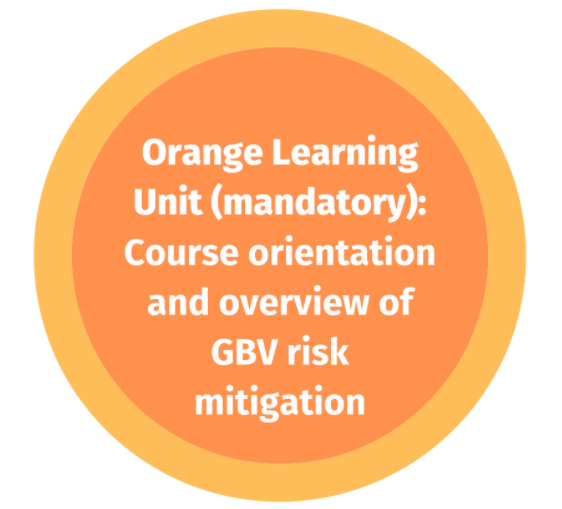Home > Capacity-Building > Integrating GBV risk mitigation into Humanitarian Action Online Course
There have been six successful cohorts of the GBV risk mitigation online course (2021, 2022, 2023 in English and French, 2024 Spanish, and 2024 Master Facilitator Training of Trainers).
This online course for non-GBV specialized humanitarian actors focuses on integrating GBV risk mitigation interventions into humanitarian action. It aims to build both knowledge and skills relevant for all clusters/sectors of humanitarian response, following the humanitarian program cycle.
This course is divided into a series of topic-specific learning units that equip participants with the knowledge and practical skills to integrate GBV risk mitigation into humanitarian action. It is not mandatory to take all learning units. Applicants are asked to indicate their preferred selections in the online course application. The GBV risk mitigation online course is run in real time and as such is highly interactive.
| Unit | Topic | |
|---|---|---|
| Orange learning unit | Mandatory | Course orientation & overview of GBV risk mitigation |
| Green learning unit | Optional | Integrating GBV risk mitigation across the Humanitarian Program Cycle |
| Blue & Red learning units | Optional | Integrating GBV risk mitigation in resource mobilization & advocacy |
| Purple | Optional | Safe and Appropriate Response to GBV Disclosures |
Please see below for additional details on the flow of the course and the objectives of each of the learning units.
This course is designed for NON-gender/GBV or Protection specialized staff including humanitarian staff from all other technical sectors (i.e.: Food Security, WASH, Shelter…) with an interest to learn more about GBV risk mitigation.
The e-learning course is accompanied by roughly weekly one-hour webinars or office hours delivered by subject matter expert facilitators. The selected cohort will learn together, from the facilitators and from each other - via videos, assignments, webinars, discussions and peer group work – throughout the duration of the course. Between self-paced e-learning and weekly webinars, it is anticipated that participants will need to spend approximately 5-6 hours per week on the course in total. Flexibility is built in for major holidays that occur during the duration of the course.
The course has been offered in English, French, and Spanish.
With generous support from CARE and UNICEF, the course is typically offered for free.

By the end of the Orange (orientation) learning unit (this one), learners should be able to:
PLEASE NOTE: The Orange unit is the only mandatory unit, however, it MUST be paired with at least one of the other units. It is not possible to take the Orange unit as a standalone. If your application to this course is successful, you must enroll in the Orange unit AND at least one other learning unit.

By the end of the Green (HPC) learning unit, learners should be able to:

By the end of the Blue (resource mobilization) learning unit, learners should be able to:
NOTE: the blue and red learning units will be combined for the 2023 course offering.

By the end of the Red (advocacy) learning unit, learners should be able to:
NOTE: the blue and red learning units will be combined for the 2023 course offering.
This site is always being updated, so please check back often for new additions, tools, and resources!
Copyright © 2025 • GBV Guidelines